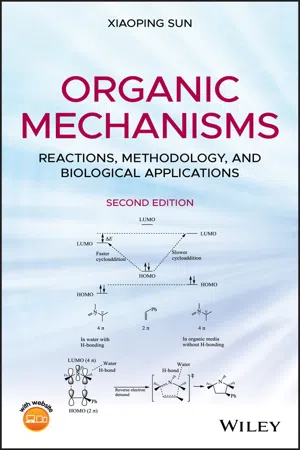
This is a test
- English
- ePUB (mobile friendly)
- Available on iOS & Android
eBook - ePub
Book details
Book preview
Table of contents
Citations
About This Book
This book helps readers move from fundamental organic chemistry principles to a deeper understanding of reaction mechanisms. It directly relates sophisticated mechanistic theories to synthetic and biological applications and is a practical, student-friendly textbook.
- Presents material in a student-friendly way by beginning each chapter with a brief review of basic organic chemistry, followed by in-depth discussion of certain mechanisms
- Includes end-of-chapter questions in the book and offers an online solutions manual along with PowerPoint lecture slides for adopting instructors
- Adds more examples of biological applications appealing to the fundamental organic mechanisms
Frequently asked questions
At the moment all of our mobile-responsive ePub books are available to download via the app. Most of our PDFs are also available to download and we're working on making the final remaining ones downloadable now. Learn more here.
Both plans give you full access to the library and all of Perlego’s features. The only differences are the price and subscription period: With the annual plan you’ll save around 30% compared to 12 months on the monthly plan.
We are an online textbook subscription service, where you can get access to an entire online library for less than the price of a single book per month. With over 1 million books across 1000+ topics, we’ve got you covered! Learn more here.
Look out for the read-aloud symbol on your next book to see if you can listen to it. The read-aloud tool reads text aloud for you, highlighting the text as it is being read. You can pause it, speed it up and slow it down. Learn more here.
Yes, you can access Organic Mechanisms by Xiaoping Sun in PDF and/or ePUB format, as well as other popular books in Physical Sciences & Organic Chemistry. We have over one million books available in our catalogue for you to explore.
Information
1
FUNDAMENTAL PRINCIPLES
1.1 REACTION MECHANISMS AND THEIR IMPORTANCE
The microscopic steps in a chemical reaction which reflect how the reactant molecules interact (collide) with each other to lead to the formation of the product molecules are defined as mechanism of the reaction. The mechanism of a reaction reveals detailed process of bond breaking in reactants and bond formation in products. It is a microscopic view of a chemical reaction at molecular, atomic, and/or even electronic level.
The structure of most organic compounds is well established by X‐ray crystallography and various spectroscopic methods with the accuracy of measurement in bond distances and angles being the nearest to 0.01 Å and 1°, respectively. Only effective molecular collisions, the collisions of the molecules with sufficient energy that take place in appropriate orientations, lead to chemical reactions. The extent of a chemical reaction (chemical equilibrium) is determined by the changes in thermodynamic state functions including enthalpy (ΔH), entropy (ΔS), and free energy (ΔG). The combination of kinetic and thermodynamic studies, quantum mechanical calculations, and geometry and electronic structure‐based molecular modeling has been employed to reveal mechanisms of various organic chemical reactions.
Reaction mechanisms play very important roles in the study of organic chemistry. The importance of mechanisms not only lies in that they facilitate an understanding of various chemical phenomena but also that mechanisms can provide guidelines for exploring new chemistry and developing new synthetic methods for various useful substances, drugs, and materials. In this regard, mechanistic studies will allow synthetic chemists to vary reaction conditions, temperatures, and proportions of chemical reagents to maximize yields of targeted pure products. For industrial chemists, mechanistic knowledge allows the prediction of new reagents and reaction conditions which may affect desired transformations. It also allows optimization of yields, reducing the costs on raw materials and waste disposals. It provides a tool for the chemists to make reactions occur in their desired ways and manufacture the ideal products. For biochemists and medicinal chemists, the microscopic view of organic reactions can help them better understand how the metabolic processes in living organisms work at molecular level, how diseases affect metabolism, and how to develop appropriate drug molecules to assist or prevent particular biochemical reactions [1].
Overall, the goal of this book is to tie reaction mechanisms, synthetic and green chemistry methodology, and biochemical applications together to form an integrated picture of organic chemistry. While the book emphasizes mechanistic aspects of organic reactions, it is a practical textbook presenting the synthetic perspective about organic reaction mechanisms appealing to senior undergraduate‐level and graduate‐level students. The book provides a useful guide for how to analyze, understand, approach, and solve the problems of organic reactions with the help of mechanistic studies.
In this chapter, fundamental principles that are required for studies and understanding of organic reaction mechanisms are briefly reviewed. These principles include basic the...
Table of contents
- COVER
- TABLE OF CONTENTS
- TITLE PAGE
- COPYRIGHT PAGE
- PREFACE
- FIRST EDITION PREFACE
- ABOUT THE COMPANION WEBSITE
- 1 FUNDAMENTAL PRINCIPLES
- 2 THE ALIPHATIC C─H BOND FUNCTIONALIZATION
- 3 FUNCTIONALIZATION OF THE ALKENE C=C BOND BY ELECTROPHILIC ADDITIONS
- 4 FUNCTIONALIZATION OF THE ALKENE C=C BOND BY CYCLOADDITION REACTIONS
- 5 THE AROMATIC C─H BOND FUNCTIONALIZATION AND RELATED REACTIONS
- 6 NUCLEOPHILIC SUBSTITUTIONS ON SP3‐HYBRIDIZED CARBONS
- 7 ELIMINATIONS
- 8 NUCLEOPHILIC ADDITIONS AND SUBSTITUTIONS ON CARBONYL GROUPS
- 9 REACTIVITY OF THE α‐HYDROGEN TO CARBONYL GROUPS
- 10 REARRANGEMENTS
- INDEX
- END USER LICENSE AGREEMENT